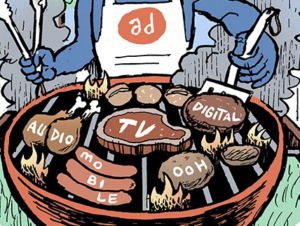 Turner Broadcasting sees a future where data and creative coexist more fluidly for TV advertisers.
Turner Broadcasting sees a future where data and creative coexist more fluidly for TV advertisers.
The company’s ad boss made a bold prediction that by 2020 50% of its networks’ inventory would be sold on an audience basis, but noted high-touch sponsorships such as the NCAA Final Four basketball championship on TBS would always exist.
Turner is giving its own organization a facelift in anticipation of these ongoing shifts in sales strategy.
“Our data science team alone has grown 12 times over the last year,” said Stephano Kim, EVP of digital strategy and operations for Turner. “Our executives wanted to transform the business from just a television media brand to a consumer-centric content production and distribution business.”
Part of this charge includes fostering a deeper understanding of its own audiences outside of Turner’s own platforms, such as on Snapchat, Facebook and YouTube. As such, it’s spurred new business divisions at Turner, including a client strategy and innovations group, as well as a unit called Turner IGNITE to rethink the ad-viewing experience.
The move led to a reduction in ad loads across some networks, including truTV and TNT, by as much as 50% in some instances. Turner believes that reducing commercial load times will improve the consumer experience even if that means there is less inventory to sell in the short term.
Turner now slots in fewer but higher-impact ads for brands that take into consideration a program’s content preceding or following the ad pod. Turner calls this new product “Native Plus.”
AdExchanger caught up with Kim to discuss the broadcaster’s latest data and content initiatives.
AdExchanger: How has your content programming strategy shifted most?
STEPHANO KIM: It used to be that back in the day, your content used to be a proxy for your audience. If someone viewed your content, the content was deemed relevant to those people. But now that you have so many different modalities of how your content is consumed, it’s changed everything.
We know that CNN consumed on Snapchat is a different audience and demographic than late-night television or Instagram and Facebook.
This is where data comes in. We have data around how audiences are consuming content across our own channels, but at the same time, the best measurer of how people consume content on Facebook is Facebook. We look at Facebook, Twitter and Google as distribution partners that may or may not have capabilities that overlap with yours. Our common interest here is the consumer, so if we can agree on economics and places we can both benefit, we can increase collaboration.
Turner recently launched a division called Turner IGNITE, to “reimagine advertising” through data and content. What does that mean?
The industry talks a lot about targeting and optimizing media buying, but I think this is going to be a big year for creative. We’re now in a place where we can make the user experience a lot more relevant to the end consumer’s mindset depending on where they are in a moment. We want to make sure we capture that psychographic [element] and have something that’s relevant to the consumer at a certain time, which is why we’re developing more bespoke, branded content on behalf of advertisers.
Are you referring to Native Plus, Turner’s new branded content initiative?
We have very forward-looking brands asking us, “How do I get more closely aligned with the content you’re providing to the end consumer?” We realized demand would only get bigger, not smaller, so we wanted to continue customizing. We want to distinguish Ford’s message from GM’s message.
This is where technology and data science can help by reducing the cycle times in the creative process. That has been one of the underpinnings of Native Plus, as well as making sure the ad real estate that’s available for that content is a little more agile and nimble to prep those media environments for more customized formats.
Can you give an example?
TruTV is a good example where in some instances we cut ad loads in half (to fit the specs of Native Plus ads). But we saw engagement numbers rise, where not only are they engaging with the content more, but they’re fully engaged with the commercial alongside it.
What we’re losing in quantity, we can certainly demonstrate a richer experience and that lets us go back to advertisers and say, “We have users fully engaged with your commercial,” and it all comes back full circle with what’s best for the user is best for us and the advertising brand. And delivering targeted ads for advertisers and improving our monetization and yield is the business we’re in, but we wanted to take this one step further. I give our management team credit for having the courage to take the risk and say we’re going to put the consumer first.
What new monetization opportunities is this opening up?
We have a production studio, which enables us to build these beautiful, bespoke native advertisements, so what are some other alternative businesses we can look at? You’ll see over the next six to nine months announcements from us around launching new business lines where the main product won’t be content. We may be in the software and data licensing business, the measurement and analytics business. We just launched a leading e-sports league that will come with a whole set of monetization streams no one has thought of yet.
 How does this change advertiser discussions?
How does this change advertiser discussions?
They’re not thinking of us as a media company. They’re thinking of us as a marketing services company where they can invest more of their assets across all parts of the portfolio.
Let’s say we work with a commercial bank. We’re not talking about a direct-response campaign to acquire more credit card customers. We’re saying, if we have 50% of our customers – where they’re not loyal, but they’re still with us – how do we get them to do more with us? That’s a targeted brand advertisement. It’s creating a tailored message to credit card holders saying, “You might want to open a checking account or consider our mortgage services offerings.” And we can put that message in the context of whether you’re passionate about this hotly contested election season or watching a lot of March Madness.
What’s next for the Turner Data Cloud, your new data management offering? Will you ultimately license viewer consumption data for external segmentation?
I’m not sure if we’re quite prepared to sell or monetize our data outright because we’re always careful about those things. But we’ve had partners and folks in the industry ask us, “Could you help us with our data science programs? Would you be willing to license your tools and technology?”
And from my perspective, on the one hand, it’s been wonderful having Turner lead in this area, but we want as many people adopting new ways of business and transacting in new ways as we can. That’s how our ecosystem benefits.
This interview has been edited for clarity and length.














